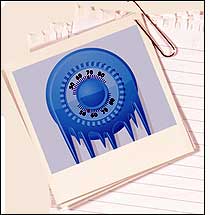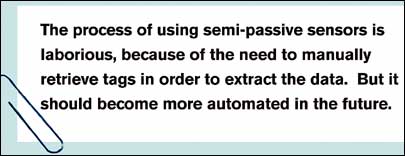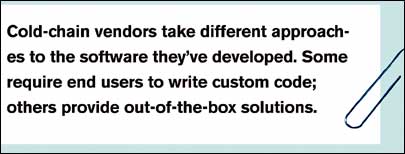Over the past few years, companies have been adopting radio frequency identification technology primarily for the purpose of track-and-trace; that is, “Where is [track] and where was [trace] my stuff?” The next logical question for many is, “What is the condition of my stuff?” The answer to that often depends on the environmental factors—such as temperature, humidity, shock and vibration—that impacted the products during shipping and handling.
Static temperature-monitoring technologies, such as digital data loggers, time-temperature indicator labels and chart recorders, have been around for many years. They require a physical connection to retrieve or output data in an analog format such as a printed strip chart. But sensor-equipped RFID tags promise to greatly improve environmental monitoring, providing better quality, less spoilage and safer products by automating the collection of data on environmental conditions and making it more cost-effective.
|
|
At the RFID Research Center at the University of Arkansas, we’ve worked with several companies on cold-chain pilots using RFID environmental sensors. The cold chain is any temperature- or environmentally controlled supply chain. The name is something of a misnomer, since the cold chain could also include those things that need to be kept hot. An environmentally controlled supply chain is often required for consumer-facing products such as pharmaceuticals, chemicals, cosmetics, fresh-cut flowers and food. But many parts used in manufacturing also require strict environmental controls to ensure proper application (such as materials used in making aircraft) or to prevent damage (such as the rusting of parts). Basically, anything that can be damaged by the environment during manufacture, shipment or storage can potentially benefit from environmental sensors.
Based on our experiences with cold-chain pilots, we’ve found that sensor-equipped RFID tags—in particular, RFID data loggers with temperature sensors, the most common sensor commercially available for use in the cold chain—offer unique advantages compared with traditional cold-chain monitoring tools. RFID data loggers record temperature digitally at set intervals. Unlike current technologies that require manual labor to retrieve the tags—some even require shipment to an off-site location for analysis—RFID data loggers can provide real-time reporting, such as when a trailer enters a shipping yard.
In addition, RFID data loggers can provide more granular temperature data. Static loggers are typically placed on top of a pallet located in the middle of a trailer. But our research suggests that the temperature of pallets within a truck can vary, depending on their location; loading patterns, such as leaving a gap through the center; the use of chutes and air ducts, which are designed to distribute cold air from the refrigeration unit more evenly throughout the truck; and pallet height and build. Temperatures also can rise and fall when a refrigeration system moves through its defrost cycle, or when a truck’s door is opened and closed. By tagging individual pallets and even cases, which is becoming cost-effective, companies can get more accurate information and take steps to extend the life of perishable goods.Active and semi-passive systems
Sensor-equipped RFID tags fall into two categories, based on power source: Active tags use an on-board battery to record sensor data and transmit it to a reader or base station; semi-passive tags use an on-board battery to record sensor data only. (While many retail track-and-trace RFID deployments use passive Gen 2 UHF tags, sensor-equipped UHF tags are still in development.)
Sensors can be triggered to capture data in different ways and under different circumstances. Typically, sensors can be set to do one or more of the following: capture data on a set interval—for example, every 30 seconds or one time per day; capture data when a preset condition is reached—say, record temperature only when it exceeds 45 degrees F; record only the average temperature during a specified time period; or record only the minimum and maximum temperatures during a specified time period. Battery life is affected by the quantity and frequency of data collection. The battery life for active tags typically ranges from one to six years; the battery life for semi-passive tags is generally around one to two years. Usually, a tag’s battery is not replaceable.
All the RFID temperature loggers we’ve worked with basically accomplish the same task, but each has different features—such as battery life, amount of memory, data-capture triggers, thermal range, sensitivity and accuracy—that affect the price of the tag. The amount of memory is an important consideration. Some RFID data loggers can store hundreds of data points—a data point contains, at minimum, a time/date stamp and a temperature reading—while others can have several thousand data points. Typical active and semi-passive tags have between 700 and 4,000 data points. It’s important to choose the tag that’s most appropriate for the specific project to help ensure a return on investment.
Active tags are often used in real-time locating systems (RTLSes), because they can track and send data over long distances, up to hundreds of feet. When active tags are equipped with temperature sensors, they’re ideal for monitoring shipping containers and refrigerated trailers in shipping yards, as well as for use in manufacturing processes. Active systems can also transmit data while in transit to a monitoring system. Active RFID readers collect data from tags throughout a trailer, which can then be relayed over a cellular data network to generate alerts or alarms. This type of monitoring allows for proactive problem resolution. If a temperature spike is recorded during transit and the dispatcher and driver are alerted, steps can be taken to prevent further damage to the product.
Most of the semi-passive data loggers we’ve worked with are high-frequency (13.56 MHz) tags, which are ideal for most temperature- and humidity-sensitive environments that don’t require real-time data collection. The commercially available HF systems we’ve used have performed well and have had few problems. Tag failures are rare, and we’ve seen excellent reliability in retrieving data from the tags. But the process of using semi-passive sensors is laborious because of the need to manually retrieve tags in order to extract data. This process should become more automated in the future.
While working on different cold-chain projects, we’ve found that cold-chain vendors take different approaches to the software they’ve developed. The software enables you to start tags and view and export a tag’s logged data. Some software enables you to configure tag profiles, such as defining the log interval and acceptable temperature range.
Some manufacturers of active and semi-passive systems provide basic applications, with the intent of end users writing custom code based on their needs, while others provide an out-of-the-box solution. Many of the manufacturers the RFID Research Center has worked with provide software that allows you to create configuration profiles, which can be transferred to multiple tags. This is especially helpful when working with a large number of tags. Features to look for when evaluating software include tag configuration profiles, high- and low-temperature alert points, and data export methods. The ability to export data is important when analyzing the temperature data from multiple tags in relation to one another. An export function to save the data in a common file format is important when seeking to run more detailed analysis with multiple tags.
Some cold-chain vendors also offer “software as a service.” Under this model, data from the tags can be reported from the RF systems—either upon retrieval, in the case of semi-passive systems, or automatically, in the case of active systems—to servers for further analysis. Having a neutral entity act as data repository offers a level of assurance when combining data from multiple parties, such as when a third-party carrier is used to transport a company’s products, to ensure that each party can only see data relevant to its own operations.Lessons Learned
The RFID equipment we’ve used performs adequately in harsh environments such as those found in cold storage; tag or reader failures have been rare in our experience.
Our cold-chain research projects have revealed several benefits of using RFID to monitor the temperature of pallets and cases in a trailer. In one pilot, for example, we placed a static logger and RFID data loggers to monitor the temperature of cases of a perishable fruit as they were transported from a farm on the West Coast to a distribution center in the Midwest. During the six-hour trip, the static logger, which was placed on one case in the middle of the trailer, did not register any drop in temperature. But the RFID data loggers, which were placed on several cases in different locations throughout the trailer, found that many cases experienced colder temperatures than were acceptable.
In another pilot project involving the transport of frozen goods, RFID data loggers showed that the daytime heating of the side of the trailer facing the sun caused the pallets and cases inside to be slightly warmer than those on the shady side of the trailer. The static loggers did not register the difference in temperatures.
From our pilots and studies using environmental sensors, we believe that using RFID to track perishables in the cold chain holds great promise. But the ubiquitous use of this technology depends on the ability to use the technology in an open-loop supply chain. Currently, the lack of interoperability among manufacturers makes it impossible for the system to be used widely in an open-loop supply chain. The proprietary nature of the current systems would force all supply-chain participants to use the same system or support multiple systems. Neither scenario is likely.
We believe that a sensor-equipped Class 3 UHF tag would solve the problem. This tag would be compatible with the Gen 2 Class 1 UHF architectures that companies are already using to track and trace products. It would also eliminate the task of having to physically remove each tag before downloading the data, because companies would be able to automatically download environmental data at key read points, such as a dock door portal.
It’s only a matter of time before technology companies develop and produce sensor-equipped Class 3 UHF tags. In the meantime, don’t wait to begin experimenting with and conducting cold-chain pilot studies with the current technology. It’s becoming increasingly more affordable to determine the temperature profile of a case, pallet or truckload of product, and this insight may prove invaluable in delivering a higher-quality, safer product to customers.Lab-Tested Tips
Consider cold-chain vendors. Whether you’re thinking about an active or a semi-passive system, you’ll need sensor-equipped RFID tags and interrogators. Typically, equipment from different vendors is proprietary and, thus, not interoperable. If you buy sensors from multiple vendors, be prepared to buy matching proprietary interrogators.
Choose the right tag for the application. For example, if you’re monitoring intercontinental shipments (especially those being shipped by sea), you need a tag with a long battery life and a large data point capacity. If you need to measure the precise temperature of a product, you’ll want to consider a probed tag, in which you insert the external temperature probe into the product. From our studies, though, we’ve found that tags placed in or around the case correlate very well with probed temperatures, so you could substitute an external temperature sensor for the invasive probe.
Verify the tags. This step is often overlooked, but it’s important to make sure the tags are recording temperature and time accurately. To verify temperature, we often use an environmental chamber, but you could use a refrigerator. Store the tags for several hours, then check the tag data against the refrigerator set point and against each other. If the tags vary too much from each other or from the set point, don’t use them.
It’s equally important to verify the accuracy of the time. If the timing device is inaccurate, it can be difficult, if not impossible, to compare temperatures across tags. For example, if tag A is off by one minute per 15-minute period over several days, it will show a date/time that is very different from tag B, which is recording properly. To verify time, check the date/time stamp in the tags’ data against a clock known to be accurate.
Plan ahead. Preparation is crucial to performing temperature analysis of a trailer. If you have access to pallet-build and trailer-loading diagrams, you can plan the tagging scheme beforehand. Unique attributes of the tagged pallets—such as the presence of an air core in the center of the pallet, the number of product types on the pallet and the pallet height—all affect the tagging scheme and the total number of tags needed.
How the pallets are situated on the truck, either staggered or straight on, influences the airflow in the trailer. If the pallets are loaded straight on, it may be possible to tag only the front, middle and back rows of pallets. But if the pallets are staggered, you might want to tag all pallets in multiple locations to determine how the loading pattern affects air temperature.Consider tag placement. Tagging locations are unique for each project and often depend on the level of detail you need. For example, if you’re trying to determine a temperature profile on a truckload of produce, several tags per pallet, in locations such as top, middle, bottom and inside/outside boxes, may be needed. If you’re trying to determine the profile of individual boxes, you’ll need to place a tag on each case of product.
Also, place the tags so they’re easy to see and retrieve. The read range on HF tags is just a few inches, so it will be necessary to get very near the tags or to physically remove them from the products. This will also make it possible to reuse the tags.
Keep a record of tag placement and pallet location. This enables identification of temperature trends based on location. When handling large quantities of tags, we number all pallets in the trailer, and write the tag location, load and pallet numbers on masking tape affixed to the tags to keep everything organized. Each tag has an identification number, but having a quick visual indicator of where that tag was on the trailer eliminates the possibility of tag mix-ups.
Look for a log-delay function in software. This feature lets you start the temperature logging after a specified time. It’s useful so you don’t have to start the tags in a cold storage environment. Otherwise, you can use a button on the tag itself or a handheld starter unit to start logging. An alternative would be to start the tag in advance of placement on a pallet and simply note the time this occurred. When analyzing data, ignore any data points before this time.
Who’s Who in Cold-Chain RFID
The RFID Research Center at the University of Arkansas has used sensor-equipped RFID tags from these companies in one or more projects. The RFID Research Center does not directly compare equipment from different vendors or endorse any products.
Coronis Systems
www.coronis-systems.com
Evidencia
www.evidencia.biz
KSW Microtec
www.ksw-microtec.de
RhiZone
www.rhizone.com
Savi Technology
www.savi.com
Sealed Air
www.turbo-tag.com
Sensitech
www.sensitech.com
Sirit
www.sirit.com
Rustin Treat is the cold-chain manager for the RFID Research Center at the University of Arkansas.




